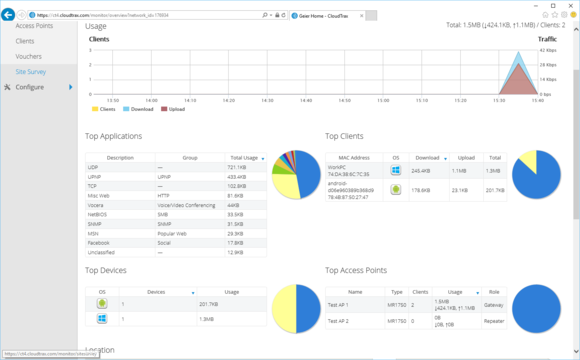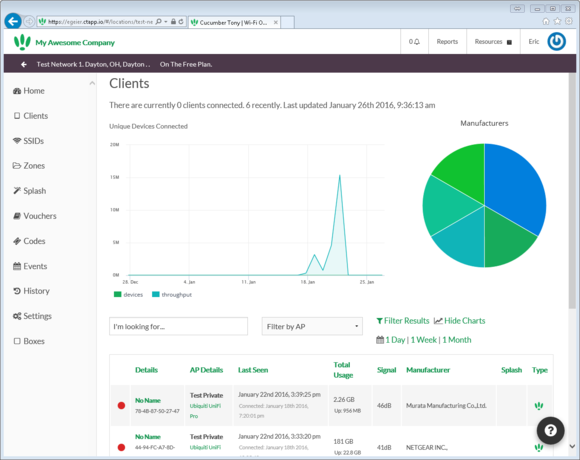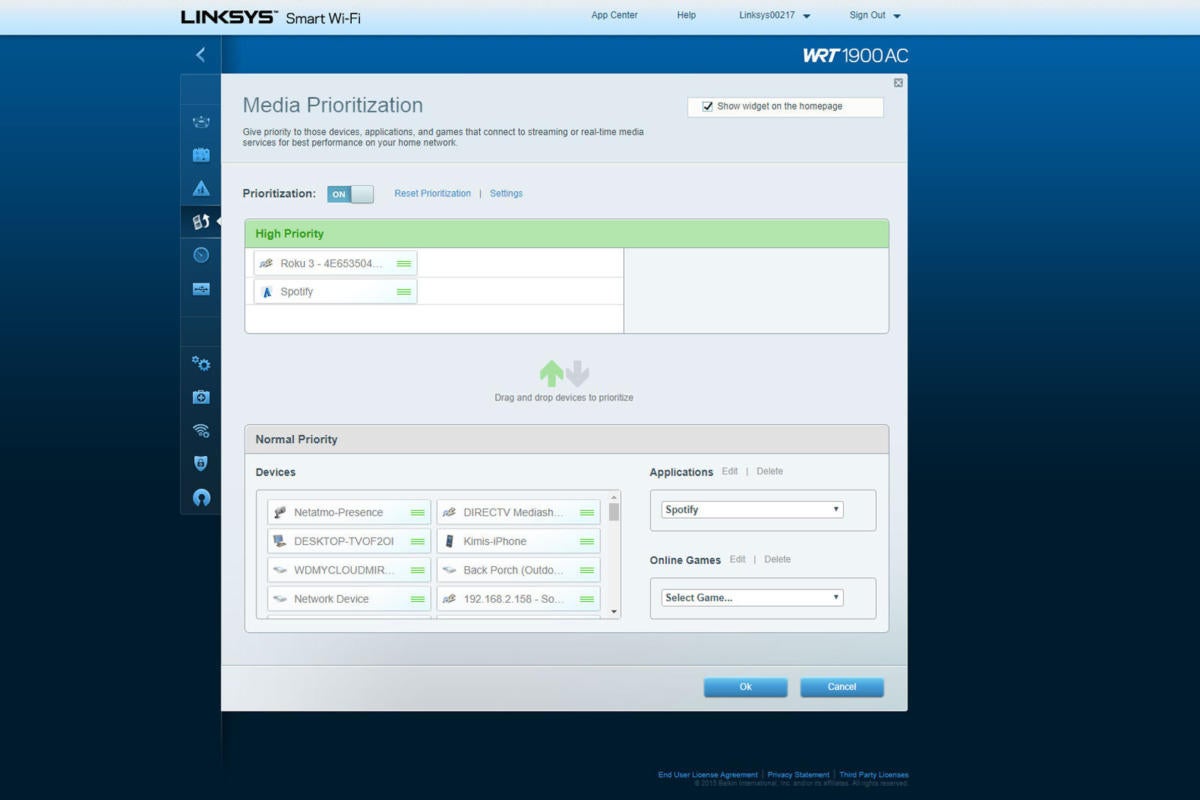Monitor your usage to identify bandwidth hogs
Whether you have a data cap or are having performance issues, consider tracking the bandwidth usage of all your devices to see who or what is hogging the most bandwidth.
You might consider using a Windows-based program like BitMeter OS (free and open-source) or NetWorx (also free), which are most useful if all or most of the internet devices on the network are Windows PCs or laptops. These applications will track usage over time for the particular computer they’re installed on, and offer up graphs and tables of data you can review. You can also set a data quota and be ale````````rted when a device approaches or exceeds that limit.
NetWorx provides detailed bandwidth reports, but only for the PCs on your network.
If you’re using multiple types of devices on the network—smartphones, tablets, gaming consoles, and TVs, in addition to computers running Windows—it would be ideal to track the entire network’s bandwidth from a single point, so you don’t have to setup tracking on each device. Since the internet traffic of each device needs to be monitored, it’s not as easy as installing a simple program on a PC. The traffic must be monitored from the router or another device strategically placed between the internet connection and the network clients.
Although most routers don’t track bandwidth consumption by network device, consider checking yours just in case. If your router doesn’t support it, consider buying another router or flashing a supported router with aftermarket firmware that does support it. If you decide to buy a new router, the enterprise-oriented Open Mesh routers and access points provide quite a bit of bandwidth usage details. Their hardware can be managed via a free online account. and it supports wireless mesh-networking technology that makes it easier to broaden your Wi-Fi coverage.
Open Mesh shows a graph of bandwidth usage of each client, top clients, top devices, top applications, and top APs on its Network Overview page.
If you don’t want to replace your router, flashing it with aftermarket firmware is a good option, provided your router has that capability. DD-WRT is one popular aftermarket firmware that supports many router brands and models; but by default, it shows only your total bandwidth usage. To find the usage per client or device, you’d also need to install an add-on like DDWRT-BWMON.
Cucumber Tony is a lesser-known firmware to consider. I reviewed it for TechHive’s sister site NetworkWorld and found that it supports a couple of different router brands. Gargoyle is another firmware you might not be familiar with. It offers some good bandwidth monitoring and control functionality, with support for a few router brands.
For the more adventurous, another option is to build your own router out of an old or spare PC, or even run it on your main PC with a virtual machine. Sophos UTM and Untangle, for instance, are operating systems that provide routing, firewall, web filtering, bandwidth monitoring, and many more network functions.
Cucumber Tony shows a graph and table of each device’s bandwidth usage on the Clients page.
Utilize your router’s QoS to distribute bandwidth
MENTIONED IN THIS ARTICLE
Most routers have a quality-of-service (QoS) feature, but it’s not enabled by default on some routers. The idea behind QoS is to regulate bandwidth usage in a way that ensures good performance on the network, particularly with more sensitive types of services such as video streams, VoIP calls, and online gaming, where any lag can be quite noticeable. It basically gives these types of traffic higher priority—on the network and to internet access from the network—compared to services that aren’t sensitive to lag (e.g., file downloads, torrents, software updates, and general web browsing).
The exact QoS features and settings vary between by router brands and models, but most provide a way for you to give particular devices higher priority by tagging their MAC or IP address, or by marking types of services for higher priority. Some routers come with a collection of default QoS settings that you can tweak and customize.
Login to your router and see if it has any QoS settings. Take a look at the default settings, as it might already give the most common services higher priority. If not, see if it allows you to classify traffic based upon the service type. I suggest going that route first to help alleviate any performance issues on the network. Secondly, you could consider prioritizing any critical devices you’d like to have higher priority.
Router manufacturers are increasingly providing the means to prioritize particular devices and apps in the router’s firmware. This Linksys WRT1900AC router has been configured to assign higher priority to traffic associated with Roku and Spotify.
Optimize your network to increase speeds
At first thought, your internet connection seems to be the bottleneck to the internet. Your local network might be able to handle up to 1000Mbps of bandwidth, while your internet-download speeds are likely less than 60Mbps (much less than that if you’re relying on DSL or—shudder—satellite internet service). You’d think that your network could easily handle it, but sometimes that’s just not the case. This is especially true when you have many devices on the network, particularly Wi-Fi devices.
You might not need super-fast speeds for every device or online service, but the quicker any device is served by the router means the more time it has to serve the other devices on the network. Thus, increasing the speeds of just one device could have an impact on the others. The more devices you get faster, the more noticeable the increased performance may be, especially for those sensitive services.
Whenever possible, connect computers and devices to the router or network via an ethernet cable. This helps alleviate the congestion on the airwaves, which is a much more complex and imperfect connection medium than a cable.
For devices that can’t be hardwired, try to utilize your router’s 5GHz frequency band as much as possible, as the 2.4GHz band is much more congested and prone to interference. For network clients that can connect only to your 2.4GHz network, check channel usage so you can use the least-crowded channel available. Additionally, ensure you’re using only WPA2 security for your Wi-Fi, as enabling the first-generation WPA (or the older and insecure WEP) limits wireless speeds.
If your wireless router doesn’t support 5GHz, I suggest upgrading to a dual-band router so you can utilize these faster and higher quality frequencies. Keep in mind, your Wi-Fi devices must also support 5GHz, otherwise they’ll still be connecting via 2.4GHz. For computers and devices that can be upgraded to 5GHz Wi-Fi–with a USB adapter, for instance–I suggest doing so. If you have multiple devices without 5GHz, I suggest upgrading the ones with any performance issues first.
Finally, evaluate your Wi-Fi coverage to ensure that your wireless router is placed in the most central spot around where you use the wireless devices most often. If you can’t locate your router in a central location, consider switching to a mesh network router, such as the Netgear Orbi, Eero WiFi system, or the Linksys Velop.
This story, “How to monitor, measure, and manage your broadband consumption” was originally published by TechHive.
Curated by: https://www.ParagonHost.net
Est. 1999 | Paragon Host Internet Group | Web, Email, Workspace | Global Hosting Services




